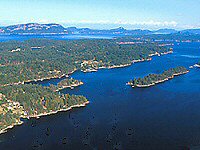|
More than just water isolates this B.C. Island Published by the Ottawa Citizen, 2004 Salt Spring Island, B.C. If you love the islands, Please Don’t Come, |
 |
Salt Spring Island, British Columbia’s lotusland par excellence, is nestled up against the southeast coast of Vancouver Island. Vancouver or Victoria is about a half-hour away by float plane, boarding and disembarking included.
At 180 square kilometers, it’s the largest of B.C.’s southern Gulf Islands, which boast Canada’s mildest climate.
Archeological evidence of aboriginal habitation of Salt Spring dates back to 3000 BC. The Cowichan called it Klaathem, meaning “salt,” while the Saanich called it CUAN, which in reference to the island’s mountainous extremities means “each end”.
Claimed for the British Crown in 1792, the island’s aboriginal population was devastated by smallpox in 1862. Survivors were resettled onto a reserve, though many aboriginal women married colonists who included Americans returning from the gold rush, a handful of freed black slaves and Hawaiians.
By 1908, logging made up 40 per cent of B.C.’s economy. For Salt Spring, that meant employment of about 150 men. And although MacMillan Bloedel amassed almost 5,000 acres in the early 1950s, the existence of an indigenous economy beyond the small farms operated by the island’s 1,755-plus inhabitants was far from apparent.
The purchase of ferry services by the B.C. Ferry Corporation in 1961 transformed the island. Owners of vacation and retirement properties multiplied as did American draft dodgers, gays, lesbians and artists and craftspeople seeking alternative lifestyles or simply escape. Building trades boomed and ferry queues became common. Small-scale organic farms and the artisans market (“Make it, Bake it or Grow it”) became so renowned that off-islanders tried to cash in.
Fights broke out between those who wanted to preserve the island’s character and those who wanted to exploit it.
You’ve got a yellow kayak and a mountain bike,
A job in the city that you just don’t like,
You come here searching for the meaning of life,
You’ll find it off, not on the island.
Attracted by Salt Spring’s beauty and amenities, affluent retirees in 1991 numbered one in five. Increasingly celebrities such as Robert de Niro, Al Pacino and Robin Williams were seen. But here, too, was Canada’s famous wildlife artists Robert Bateman, folksinger Valdy, musician Randy Bachman, National Post columnist Elizabeth Nickson and prairie filmmaker Anne Wheeler.
When it came time to lead the fight against logging, it was arch eco-feminist Andrea Collins, wife of megastar Phil Collins, who organised the women to disrobe amidst the old-growth forests and create one of the world’s first wildly successful calendar fundraisers.
A chapter of the Raging Grannies also arrived, as did the Internet and cell phone-using professionals who commuted by float plane. Smart restaurants, organic eateries, shops dispensing alternative therapies and multimillion dollar mansions sprouted discreetly.
We change our names and our houses too,
Long-term couples are very few.
You’ve got a relationship important to you,
Keep it off, not on the island.
Today, Salt Spring’s population is around 10,000. Surprisingly, it’s leveled out. Not surprisingly, it’s because few can afford to buy anymore. In fact, property is so pricey that two RCMP officers left the island recently.
“We don’t want to become an island just for the rich,” says Eric Booth, Salt Springs Island local trustee, “like Nantucket or Aspen, where people who run services do volunteer work create communities and pay taxes all disappear.”
The island’s other local trustee, Kimberly Lineger, agrees. “Even now, a ferryload of people leave the island every day to work elsewhere and a ferryload of people arrive to work on the island.” To create affordable housing, some islanders hope to establish a community land trust, which would allow homes to be built and sold on publicly held land.
Other ideas for the island’s future include wider use of the locally designed Salt Spring currency and speculation about becoming an offshore tax haven. The island’s articulate, committed and disputatious inhabitants will undoubtedly fight about this, as they have everything else.
We’re a bunch of gofers wearing rubber boots,
We don’t much like those men in suits.
You got lots of money and are quiet too.
Keep it off, not on the island.
Ottawa doesn’t matter much around here.